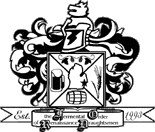 |
 |
 |
 |
 |
 |
| October 2002 | Fermental Order of Renaissance Draughtsmen | Vol. 10 No. 10 |
The next meeting will be held back at Bailey's Pub 'N Grille in Dearborn on Tuesday, October 22 . Bailey's is located on the southeast corner of Michigan and Mason. Their address is 22091 Michigan Avenue and their phone number is 313-277-3212. As usual, the thirsty hard-core who want dinner will start arriving around 5PM, people will drift in for an hour or so, and we will start our meeting around 6PM.
The winners from the August Strong Belgian Ale Competition are:
| Strong Belgian Ale | |||
| Place | Name | Style | Points |
| 1 | Chris Frey | BFB | 43/50 |
| 1 | Chris Frey, Doug Geiss, Kathy Loftus | Tripel | 43/50 |
| 2 | Chris Frey, Doug Geiss, Kathy Loftus | Tripel | 41/50 |
| 3 | Chris Frey, Doug Geiss, Kathy Loftus | Tripel | 40.25/50 |
| HM | Mike Arend | Dubbel | 36/50 |
| HM | Chris Frey, Doug Geiss, Kathy Loftus | Dubbel | 35.75/50 |
| HM | Chris Frey | Tripel | 28.75/50 |
The results for the mild competition are in the table below.
| Mild | |||
| Place | Name | Style | Points |
| 1 | Bob and Kim Barrett | Dark Mild | 40/50 |
| 2 | Chris Frey | Mild Ale | 39/50 |
| 3 | Tyler Barber | Mild Ale | 35/50 |
| 3 | Doug Geiss &Kathy Loftus | Dark Mild | 35/50 |
October's competition will be Fruit and Spice Beer - BJCP Categories 21 & 22 .
21. FRUIT BEER
Aroma: The character of the particular fruit(s) should be distinctive in the aroma. Overall the aroma should be a balanced combination of malt, hops and the featured fruit(s) as appropriate to the specific type of beer being presented. If the base beer is an ale then general fruitiness and other fermentation byproducts such as diacetyl may be present as appropriate for the warmer fermentation. If the base beer is a lager, then overall less fermentation byproducts would be appropriate. Some malt aroma preferable, especially in dark styles; hop aroma absent or balanced with fruit, depending on the style. The overall aroma should be balanced and harmonious.
Appearance: Appearance should be appropriate to the base beer being presented and will vary depending on the base beer. For lighter beers with fruits that exhibit distinctive colors, the color should be noticeable.
Flavor: The character of the particular fruit(s) should be distinctive in the flavor profile. Hop bitterness, flavor, malt flavors, alcohol content and fermentation byproducts, such as diacetyl, should be appropriate to the base beer and harmonious and balanced with the distinctive fruit flavors present.
Mouthfeel: Mouthfeel may vary depending on the base beer selected and as appropriate to that base beer. Body and carbonation levels should be appropriate to the base beer style being presented.
Overall Impression: A harmonious marriage of fruit and beer.
Comments: Overall balance is the key to presenting a well-made fruit beer. The fruit should complement the original style and not overwhelm it. The brewer should recognize that some combinations of base beer styles and fruits work well together while others do not make for harmonious combinations. The entrant must specify the underlying beer style as well as the type of fruit(s) used. If the base beer is a classic style, the original style should come through in aroma and flavor. Judges should remember that many fruits dry out classic styles.
Vital Statistics: OG, FG, IBUs, SRM and ABV will vary depending on the underlying base beer.
Commercial Examples: Oxford Raspberry Wheat, Oregon Blackberry Porter, Pyramid Apricot Ale, Rogue 'n' Berry, Brimstone Blueberry Wheat, Oaken Barrel Raspberry Wheat.
22. SPICE/HERB/VEGETABLE BEER
Aroma: The character of the particular spices, herbs and/or vegetables (SHV) should be distinctive in the aroma. Overall the aroma should be a balanced combination of malt, hops and the featured SHV(s) as appropriate to the specific type of beer being presented. If the base beer is an ale then general fruitiness and other fermentation byproducts such as diacetyl may be present as appropriate for the warmer fermentation. If the base beer is a lager, then overall less fermentation byproducts would be appropriate. Some malt aroma preferable, especially in dark styles; hop aroma absent or balanced with the SHVs used, depending on style. The overall aroma should be balanced and harmonious.
Appearance: Appearance should be appropriate to the base beer being presented and will vary depending on the base beer. For lighter beers with spices, herbs or vegetables that exhibit distinctive colors, the colors should be noticeable.
Flavor: The character of the particular SHV(s) should be distinctive in the flavor profile. Hop bitterness, flavor, malt flavors, alcohol content, and fermentation byproducts, such as diacetyl, should be appropriate to the base beer and harmonious and balanced with the distinctive SHV flavors present.
Mouthfeel: Mouthfeel may vary depending on the base beer selected and as appropriate to that base beer. Body and carbonation levels should be appropriate to the base beer style being presented.
Overall Impression: A harmonious marriage of spices, herbs and/or vegetables and beer.
Comments: Overall balance is the key to presenting a well-made spice, herb or vegetable (SHV) beer. The SHV should complement the original style and not overwhelm it. The brewer should recognize that some combinations of base beer styles and SHVs work well together while others do not make for harmonious combinations. The entrant must specify the underlying beer style as well as the type of SHV(s) used. If the base beer is a classic style, the original style should come through in aroma and flavor. Additionally, whenever multiple spices, herbs or vegetables are used each should be distinctive in their own way.
Vital Statistics: OG, FG, IBUs, SRM and ABV will vary depending on the underlying base beer.
Commercial Examples: Harpoon Winter Warmer, Ed's Cave Creek Chili Beer, Buffalo Bill's Pumpkin Ale, Anchor Our Special Ale, Wild Onion Pumpkin Ale.

 |
 |
 |
 |
 |
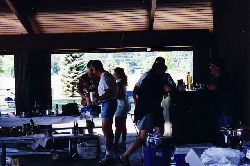 |
 |
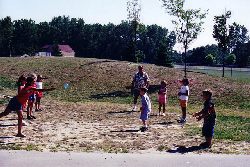 |
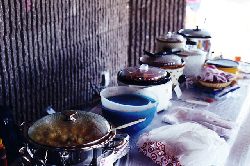 |
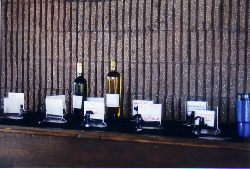 |
The winning recipe, five years ago, in the "Weiss is Nice" competition was from Gary Shewchuk.
6# Munton & Fison 55% Dry Wheat Extract (Unhopped)
1 oz. Tettenanger Hop Pellets
Wyeast Weihenstephen Yeast
Boil time 60 min.
Add extract and hops, boil for 60 min. Cool.
O.G. = 1.048
F.G. = 1.011
12 day primary @ 74 F
Bottled with 3/4 cup corn sugar.
Next month's competition is non-beer (wine, sake, mead, cider) fermented beverages. BJCP category 25 is mead and 26 is cider. These two styles are given below.
25. MEAD
25A. Traditional Mead
Aroma: Honey aroma should dominate, which may be sweet and may express the aroma of flower nectar. Aromas produced during fermentation, such as fruity esters and alcohol, may also be present.
Appearance: Clarity may be good to brilliant. Carbonated examples will show active evidence of dissolved gas but no head is expected. Color may range from pale straw to deep amber.
Flavor: The flavor of honey should be featured and may include residual sweetness. Any additives, such as acidity or tannin, should enhance the honey flavor and lend balance to the overall character of the mead.
Mouthfeel: Smooth texture. Most will be wine-like, with the warming presence of alcohol and sense of medium body. Sensations of a cloying or astringent character should be avoided.
Comments: A mead made primarily from honey, water and yeast. Meads which feature the character of a blended honey or a blend of honeys. For meads made from a single variety of money see below “B, Varietal Honey Traditional Mead.” While some oxidation of mead is OK and can actually lend useful complexity to the mead, over oxidation as exhibited by sherry-like aroma and/or taste should be avoided. Phenols produced by high temperature fermentation are also to be avoided. Entrants must specify whether the entry is still or sparkling mead. Entrants must also indicate whether the mead is dry, semi-sweet or sweet.
Vital Statistics: Effective OG: 1.070-1.120+
IBUs: N/A FG: 0.995-1.025
SRM: 1-16 ABV: 7.5-15+%
25B. Varietal Honey Traditional Mead
Aroma: Honey aroma should dominate, which may be sweet and may express the aroma of flower nectar. Aromas produced during fermentation, such as fruity esters and alcohol, may also be present. The particular Varietal honey aroma (such as orange blossoms for orange blossom honey) should be evident.
Appearance: Clarity may be good to brilliant. Carbonated examples will show active evidence of dissolved gas but no head is expected. Color may range from pale straw to deep amber.
Flavor: The flavor of honey should be featured and may include residual sweetness. The distinctive taste of the Varietal honey should be showcased. Any additives, such as acidity or tannin, should enhance the honey flavor and lend balance to the overall character of the mead.
Mouthfeel: Smooth texture. Most will be wine-like, with the warming presence of alcohol and sense of medium body. Sensations of a cloying or astringent character should be avoided.
Comments: Mead made from honey from a particular flower source. The brewer must name the varietal honey. Note that the character of a varietal honey will be identifiable as distinct to the source, but may not resemble the source. Orange-blossom honey has the character of orange blossoms, not oranges. Blackberry honey is only distantly like blackberries, although it is an identifiable character. While some oxidation of mead is OK and can actually lend useful complexity to the mead, over oxidation as exhibited by sherry-like aroma and/or taste should be avoided. Phenols produced by high temperature fermentation are also to be avoided. Entrants must specify whether the entry is still or sparkling mead. Entrants must also specify whether the entry is dry, semi-sweet or sweet.
Vital Statistics: Effective OG: 1.070-1.120+
IBUs: N/A FG: 0.995-1.025
SRM: 1-16 ABV: 7.5-15+
25C. Cyser (Apple Melomel)
A mead made with the addition of apples or apple juice. Traditionally, cysers are made by the addition of honey to apple juice without additional water.
Aroma: Should have distinct apple character with a pronounced honey aroma, which may be sweet and may express the aroma of flower nectar. Aromas produced during fermentation, such as fruity esters, low levels of sulfur and alcohol, may also be present.
Appearance: Clarity may be good to brilliant. Carbonated examples will show active evidence of dissolved gas but no head is expected. Color may range from pale straw to deep amber.
Flavor: Should have distinct apple character but should also have a balanced honey character. The Apple character may supply tart acidity to cut the honey sweetness, so one may notice tart acidity first and residual sweetness thereafter. Any additives, such as acidity or tannin, should enhance the honey flavor and lend balance to the overall character of the cyser. In well made examples of the style, the fruit is both distinctive and well-incorporated into the sugar-acid balance of the mead. Some of the best examples have the taste and aroma of an aged Calvados (apple brandy from northern France).
Mouthfeel: Smooth texture. Most will be wine-like, with the warming presence of alcohol and sense of medium body. Sensations of a cloying or astringent character should be avoided.
Comments: There should be an appealing blend of the fruit and honey character but not necessarily an even balance. Generally a good tannin-sweetness balance is desired, though very dry and very sweet examples do exist. Entrants must specify whether the entry is still or sparkling cyser. Entrants must also specify whether the entry is dry, semi-sweet or sweet.
Vital Statistics: Effective OG: 1.070-1.120+
IBUs: N/A FG: 0.995-1.025
SRM: 1-16 ABV: 7.5-15+%
25D. Pyment (Grape Melomel)
A mead made with the addition of grapes or grape juice. Alternatively, the pyment may be a grape wine sweetened with honey, a mixture of grape juice and honey that is fermented or a mixture of grape wine and mead mixed after fermentation.
Aroma: Should have distinct grape or grape-wine character with a pronounced honey aroma, which may be sweet and may express the aroma of flower nectar. Aromas produced during fermentation, such as fruity esters and alcohol, may also be present.
Appearance: Clarity will be good to brilliant. Carbonated examples will show active evidence of dissolved gas but no head is expected. Color would reflect the grape source, whether white, red or other.
Flavor: Should have distinct grape wine character, manifested in acidity, tannin and other grape characteristics, but the honey character should balance the fruit flavors. Grassy white wine character or buttery(diacetyl) Chardonnay character is appropriate in pyment only. In well made examples of the style, the fruit is both distinctive and well-incorporated into the sugar-acid balance of the pyment.
Mouthfeel: Smooth texture. Most will be wine-like, with the warming presence of alcohol and sense of medium body. Sensations of a cloying or astringent character should be avoided.
Comments: There should be an appealing blend of the fruit and honey character but not necessarily an even balance. Generally a good tannin-sweetness balance is desired, though very dry and very sweet examples do exist. Entrants must specify whether the entry is still or sparkling pyment. Entrants must also specify whether the entry is dry, semi-sweet, or sweet.
Vital Statistics: Effective OG: 1.070-1.120+
IBUs: N/A FG: 0.995-1.025
SRM: 1-16 ABV: 7.5-15+%
25E. Other Fruit Melomel
A mead made with the addition of other fruit or fruit juices. There should be an appealing blend of the fruit and honey character but not necessarily an even balance.
Aroma: Should exhibit the aroma of the fruit(s) present in the mead. In a melomel with a blend of fruits, one fruit may dominate the aroma profile.
Appearance: Clarity will be good to brilliant. Carbonated examples will show active evidence of dissolved gas but no head is expected. The particular fruit(s) used may or may not impart color to the mead.
Flavor: Fruit flavor contributions to the mead range from subtle acidic notes to intense, instantly recognizable fruit flavors. In a melomel with a blend of fruits, one fruit may dominate the flavor profile. There should be a balanced honey character as well. Some fruits will lend a cloying sweetness to the mead while others add a drying character. In well- made examples of the style, the fruit is both distinctive and well-incorporated into the sugar-acid balance of the mead.
Mouthfeel: Smooth texture. Most will be wine-like, with the warming presence of alcohol and sense of medium body. Sensations of a cloying or astringent character should be avoided.
Comments: Generally a good tannin-sweetness balance is desired, though very dry and very sweet examples do exist. Some fruits, notably darker ones like Blackberries, may contribute a tannin presence not unlike dark pyments. Some oxidative properties may be appropriate in certain fruit meads, giving them a sherry or port wine character. Entrants must specify whether the entry is still or sparkling mead. Entrants must also specify whether the mead is dry, semi-sweet or sweet.
Vital Statistics: Effective OG: 1.070-1.120+
IBUs: N/A FG: 0.995-1.025
SRM: 1-16 ABV: 7.5-15+%
25F. Metheglin
A mead made with the addition of spices or herbs.
Aroma: The spices/herbs may be expressed in the aroma. Honey characters should appear in the aroma but will vary in intensity depending on the spices/herbs used. Metheglins containing more than one spice should have a good balance among the different spices/herbs, though some spices/herbs will tend to dominate the aroma profile.
Appearance: Clarity may be good to brilliant. Carbonated examples will show active evidence of dissolved gas but no head is expected. Color may range from pale straw to deep amber; the color usually won't be affected by the spices or herbs.
Flavor: The spices/herbs should be expressed in the flavor but the honey character is still the backbone of the mead and should appear in the flavor but will vary in intensity depending on the spices/herbs used. The spices/herbs should be expressed in the flavor as a distinctive enhancement to the honey flavor, whether harmoniously or by contrast, and should achieve a pleasant balance when a blend of spices/herbs is used. Metheglins containing more than one spice should have a good balance among the different spices/herbs, though some spices/herbs will tend to dominate the flavor profile.
Mouthfeel: Smooth texture. Most will be wine-like, with the warming presence of alcohol and sense of medium body. Sensations of a cloying or astringent character should be avoided; however, some spices or herbs may affect mouthfeel particularly by adding astringency.
Comments: Often, a blend of spices may give a character greater than the sum of its parts. The better examples of this style use spices/herbs subtly and when more than one are used, they are carefully selected so that they blend harmoniously. Entrants must specify whether the entry is still or sparkling mead. Entrants must also specify whether the mead is dry, semi-sweet or sweet.
Vital Statistics: Effective OG: 1.070-1.120+
IBUs: N/A FG: 0.995-1.025
SRM: 1-16 ABV: 7.5-15+%
25G. Braggot
Meads made with both honey and malt providing flavor and fermentable extract. Originally, and alternatively, a mixture of mead and ale.
Aroma: Aroma of both honey and malt should be apparent and in balance. Hop aroma may be present but is not required.
Appearance: Straw to dark brown depending on the type of malt and honey used. Some head retention is expected. Clear, although some chill haze may be present at low temperatures.
Flavor: There should be some balance between the beer aspect and the mead aspect of a braggot, especially with regard to maltiness and bitterness versus honey character. Malt character ranges from light pale malt-type flavors to rich caramel flavors, depending on the malt used. Hop bitterness and flavor may be present but are not required.
Mouthfeel: Body may vary from light to medium. Smooth mouthfeel without astringency. Carbonation may vary from light to very lively.
Comments: The fermentable sugars should come from a balance of malt and honey, otherwise the beverage might better be entered as a Specialty Beer with the addition of honey. As a rule of thumb, the fermentables should consist of no less than 1/3 malt and no more than 2/3 honey. Hopped examples of this style should exhibit the hops distinctly and should have at least 15 IBUs.
Vital Statistics Effective OG: 1.060-1.120+
IBUs: 0-50 FG: 1.004-1.025
SRM: 3-16 ABV: 6.5-14%
25H. Mixed Category Mead
A mead that combines ingredients from two or more of the other mead sub-categories.
Aroma, appearance, flavor and other characteristics may vary and be combinations of the respective elements of the various sub-categories used in this style.
Comments: This mead should exhibit the character of all of the ingredients in varying degrees, and should show a good blending or balance between the various flavor elements.
26. CIDER
26A. Standard Cider and Perry
Aroma: Apples (pears, if a perry) should be distinctive and dominate. There may be some fermentation byproducts such as esters, alcohols and low levels of sulfur.
Appearance: Pale yellow to amber in color. Clear and brilliant. Carbonation may vary from absolutely still to very vigorous, as follows, Entrant must specify still or carbonated (level of carbonation optional):
Still: No carbonation visible or in the mouthfeel.
Petillant: Very lightly sparkling, visibly and in the mouth.
Sparkling: Clearly but not heavily carbonated.
Spuming or Spumante: Heavily and vigorously carbonated, bordering on gushing, with tight, fine bubbles, champagne-like.
Flavor: Crisp apple (pear) flavor should be present and distinctive. May be dry to sweet. Some noticeable alcohol character may be present at the upper end of the range (7%). There should be a balance in the acidic character and the residual sweetness.
Mouthfeel: Light body. No astringency. No carbonic bite from CO2.
Comments: Sugar adjuncts may be used. May be fermented by wine, Champagne, ale, lager or wild yeast. The entrant must also specify whether the entry is a cider or perry; dry, semi-dry or sweet; still or carbonated. If both apple and pear juice are used the entry must be entered as a special cider. Artificial carbonation is allowed. The method of carbonation need not be specified.
Vital Statistics: OG: 1.045-1.061
IBUs: NAp; FG: 0.990-1.012
SRM: 3-12 ABV: 4.5-7%
Commercial Examples: Broadoak, Hecks, Dunkerton's, Franklins, Rich's Framhouse Cider (all available only in England), Clos Normand, Herout Fils, Hornsby's Draft Cider (not the “Granny Smith” or “Amber”), Sidra El Gaitero, Kelly's Traditional Irish Premium Hard Cider, Minchew Perry (available only in England), Wyder's Pear Cider.
26B. New England-Style Cider
Aroma: Strong, pronounced apple aroma. The higher level of alcohol,8-14%, will be more noticeable in the aroma. Other fermentation byproducts may also be present.
Appearance: Pale to medium yellow. Still or sparkling. Carbonation must be natural. Clear and brilliant.
Flavor: Strong apple flavor. Usually dry. No hot alcohol taste. New England-Style cider is distinguished from other styles by its robust and sometimes unsophisticated taste. It is a rustic, homemade product, typically more forceful than delicate. Nevertheless, complexity and structure are often present.
Mouthfeel: Medium to full-bodied with some tannins.
Comments: Adjuncts may include white and brown sugars, molasses, honey (very sparingly), and/or raisins. Should use wild or wine yeast only. Entrants must specify whether still or sparkling and whether dry, semi-sweet or sweet.
Vital Statistics: OG: 1.061-1.105
IBUs: N/A FG: 0.990-1.010
SRM: 3-5 ABV: 7-14%
Commercial Examples: There are no known commercial examples of New England-style cider.
26C. Specialty Cider And Perry
Aroma: Apples (pears) should be distinctive and dominate. There may be some fermentation byproducts such as esters, alcohols and low levels of sulfur. Aromas from identified fruits and spices should also be noticeable as well.
Appearance: Carbonation may vary from absolutely still to very vigorous. Pale yellow in color, except where adjuncts such as spices or fruit may introduce a deeper shade or another color. Clear and brilliant.
Flavor: Crisp apple (pear) flavor should be present and distinctive. Declared adjuncts must be present in the taste and integrate well with the base cider. May be dry to sweet. Some noticeable alcohol character may be present but the emphasis should be on alcoholic warming, not the taste or harsh bite of alcohol in the mouth. There should be a balance in the acidic character and the residual sweetness.
Mouthfeel: Light to full body.
Comments: Sugar adjuncts may be used. May be fermented by wine, Champagne, ale, lager or wild yeast. There may be optional ingredients such as fruits and spices in which case the entrant must identify these. The entrant must also specify whether the entry is; dry, semi-dry or sweet; still or carbonated. Artificial carbonation is allowed. The method of carbonation need not be specified. The entrant must be careful in the use of honey as an adjunct; if the honey is the dominant fermentable the entry is a Cyser and must be entered in the Mead competition and not as a cider.
Ingredients: At least 75% apple (pear) juice with the remainder made from any variety of adjuncts. The alcohol content must be below 14%, but any type of yeast can be used in the production.
Vital Statistics: OG: 1.061-1.105
IBUs: N/A FG: 0.990-1.010
SRM: 3-12 ABV: 7-14%
Commercial Examples: Cider Jack fruit ciders.
| Beer Events, Meetings & Competitions |  |
| Ye Olde Brew News
published by the F.O.R.D. Homebrew Club |
|
| Editor:
Tony Tantillo Contributors:
Club Officers: |
F.O.R.D. is a private, non-profit organization of homebrewers. The main goal of this club is to
promote awareness and appreciation of the quality and variety of beer; to share information regarding technique, equipment and skill
required to brew quality homemade beer; and to encourage responsible use of beer as an alcohol-containing beverage.
Howard Klix Jr. 24737 Cushing Ave Eastpointe, MI 48021 Phone: (586) 779-1445
Visit our website at: http://www.be.ford.com/brewers/
current circulation... 125 |